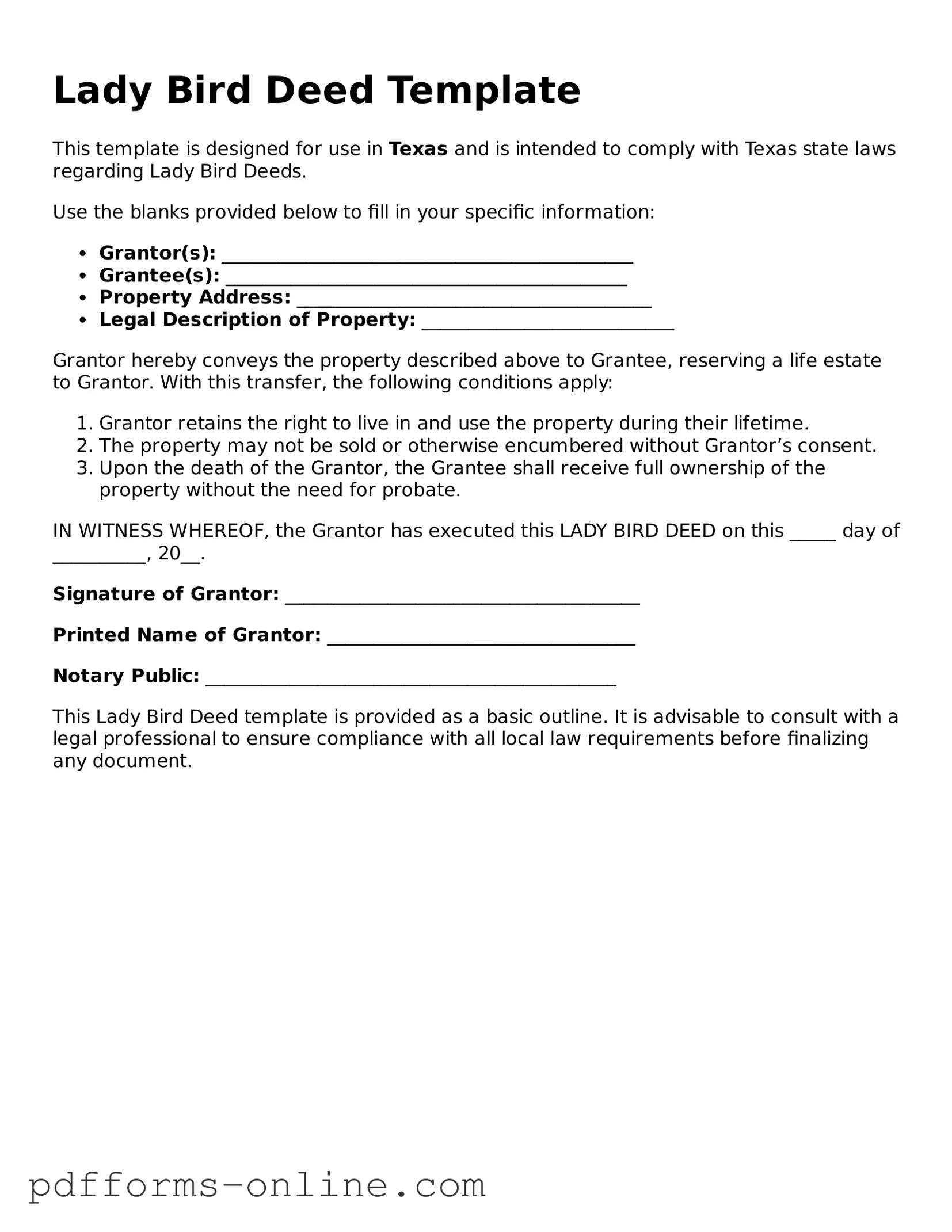The Lady Bird Deed, also known as an enhanced life estate deed, allows property owners to transfer their real estate to beneficiaries while retaining the right to live in and control the property during their lifetime. Similar to this deed is the traditional life estate deed. In a life estate deed, the property owner transfers ownership to another party but retains a life estate, meaning they can live on the property until death. Unlike the Lady Bird Deed, the traditional life estate does not allow the original owner to sell or mortgage the property without the consent of the remainderman, the person who will inherit the property after the owner's death.
Another document akin to the Lady Bird Deed is the transfer-on-death deed (TOD). A TOD allows property owners to designate beneficiaries who will receive the property automatically upon the owner's death, bypassing probate. While both the Lady Bird Deed and the TOD facilitate the transfer of property outside of probate, the key difference lies in the rights retained by the owner. The Lady Bird Deed allows for greater control during the owner’s lifetime, including the ability to sell or mortgage the property without needing consent from the beneficiaries.
The quitclaim deed is another document that shares similarities with the Lady Bird Deed. A quitclaim deed transfers whatever interest the grantor has in the property to the grantee without any warranties. While it does not provide the same lifetime rights as the Lady Bird Deed, it can be used to transfer property among family members. However, unlike the Lady Bird Deed, the quitclaim deed does not allow the original owner to retain any rights or control over the property after the transfer.
The warranty deed also resembles the Lady Bird Deed in that it transfers ownership of property. A warranty deed guarantees that the grantor holds clear title to the property and has the right to sell it. While both deeds facilitate property transfers, the warranty deed does not retain any rights for the original owner, unlike the Lady Bird Deed, which allows the owner to live on and manage the property during their lifetime.
A revocable living trust is another estate planning tool similar to the Lady Bird Deed. This legal entity allows individuals to place their assets, including real estate, into a trust while retaining control over those assets during their lifetime. Upon death, the assets can be transferred to beneficiaries without going through probate. While both the Lady Bird Deed and a revocable living trust help avoid probate, the trust does not provide the same immediate control over the property as the Lady Bird Deed does.
The general power of attorney can also be compared to the Lady Bird Deed. This document grants someone the authority to act on behalf of another person in financial or legal matters. While it does not transfer property ownership, it allows the agent to manage real estate assets, including selling or renting them. The Lady Bird Deed, however, specifically pertains to the transfer of property rights while allowing the original owner to retain control over the property during their lifetime.
The special warranty deed is similar to the Lady Bird Deed in that it provides a limited guarantee of title. This type of deed ensures that the grantor is responsible for any claims or issues that arose during their ownership. While both documents facilitate property transfers, the special warranty deed does not allow the original owner to maintain any rights over the property, unlike the Lady Bird Deed, which provides lifetime rights to the original owner.
Understanding the nuances of property transfer methods, including the Lady Bird Deed, is essential for effective estate planning. It's important to analyze how these tools interact with agreements like the onlinelawdocs.com/ that can help manage liability and protect interests during property use. Each document, from revocable living trusts to quitclaim deeds, offers unique advantages and implications, making it crucial to choose the right approach based on individual circumstances.
The living will, while not a property transfer document, can be considered similar in its intent to express the owner’s wishes. A living will outlines an individual’s preferences for medical treatment in case they become incapacitated. While it does not deal with property, it reflects the owner's desire to maintain control over their affairs, akin to the way a Lady Bird Deed allows for control over property during one's lifetime.
Lastly, the joint tenancy deed shares some characteristics with the Lady Bird Deed. In a joint tenancy arrangement, two or more individuals own property together, with rights of survivorship. This means that when one owner passes away, their share automatically transfers to the surviving owner(s). While both documents facilitate the transfer of property upon death, the Lady Bird Deed allows for more control during the owner’s lifetime, whereas joint tenancy involves shared ownership and rights among multiple parties.
